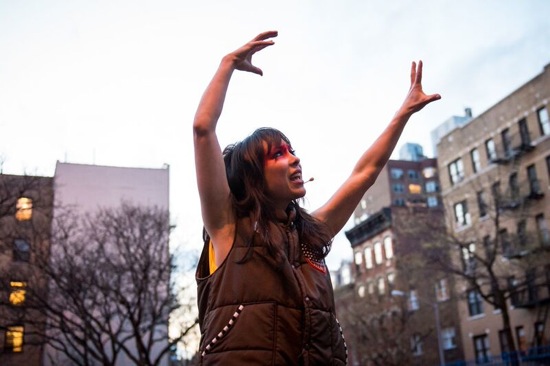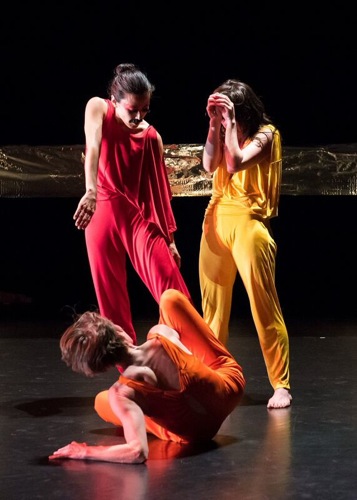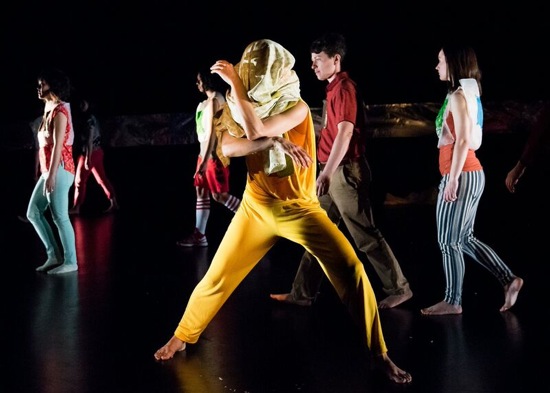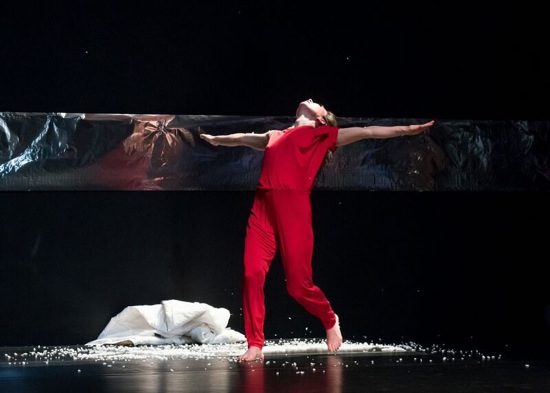Emily Johnson/Catalyst creates communities in our city.

Emily Johnson speaking to spectators gathered at P.S. 11 before the performance of her Shore at New York Live Arts. Photo: Ian Douglas
Emily Johnson’s Shore, the third part of a trilogy that was preceded by the Bessie-award-winning The Thank-You Bar and Nicugni, did not consist only of the performance that appeared at New York Live Arts from April 23-25. Beginning April 19, there were related community action events (land, water, and dune restoration) in the Rockaways and on Governors Island, a curated reading of stories on Rutgers Slip in downtown Manhattan, and a final potluck feast at the North Brooklyn Boat Club. The Governor’s Island event focused on the efforts to reseed the oyster beds that once existed in the waters there. Twenty partnering organizations are listed in the program insert. For Johnson, art should not be separated from community.
Her company, Emily Johnson/Catalyst, is based in Minneapolis, but Johnson grew up in Alaska of Yu’pik descent and took with her into her art-making the family and community endeavors of salmon fishing and curing and moose butchering that she grew up with, as well as the stories handed down through generations. She has written that the trilogy is “a response to displacement, to feeling disconnected from place, people, ceremony, and tradition.” The performances here of Shore were not referred to as the “New York version,” but as the Lenapehoking one, acknowledging the land occupied by the Lenape tribe—a territory that comprised adjoining parts of Delaware, Pennsylvania, New Jersey, Long Island, and the lower Hudson Valley.
It was unseasonably cold for the Friday night performance. Spectators arriving early at NYLA could take a woven red blanket from a pile and walk together to the West 21st Street and the basketball court of P.S. 11, where Shore was to begin. Others were not so lucky. The weather, however, built impromptu communities, and groups huddled together, making walls of their blankets. Telling events had begun. A cluster of performers—pressed together facing outward, and swaying—gradually disappeared, as, one by one, people left it and walked out of sight or were absorbed into the shivering crowd. Johnson was assisted onto a platform of some kind, and towering above us, began to speak.
Her manner is beguiling. On this occasion, she’s not “making a speech,” she’s telling us things, as if the words were coming to her at this very moment. Her talk is of nature—the natural world that lies below the concrete we stand on, the world where a creek may once have run, a world that a large nearby tree’s roots grope toward. In a patch of sky, the crescent moon and Venus are communing. On the sidewalk outside the fence, a few people turn out to be performers, singing as they walk east—so many steps forward, fewer steps back, until they disappear. There’s also a big circle; we watchers are not in it; it surrounds us. Those who circle us begin by walking, work their way into a run, calm back down into a walk. Their vocalizing creates a permeable wall of sound.
The communal route back to NYLA proceeds east on 21st Street, downtown on 7th Avenue, and west on 19th Street; further east, deep under this concrete sidewalk, lies the channel of the once-upon-a-time Minetta Creek, where the Lenape drew their water. No one knows whether it still pools down there.

Aretha Aoki (in red), Emily Johnson (in yellow), and Krista Langberg (in orange) in Johnson’s Shore. Photo: Ian Douglas
There’s something mysteriously beautiful about what happens in the theater. You may not understand the significance of everything, or what lies beneath it like another hidden river, but the intentness of the performers catches you; everything they do has the aura of meaningfulness.
The piece created by Johnson and directed by Ain Gordon juxtaposes three women dancers (Aretha Aoki, Krista Langberg, and Johnson) to an assembled society of performers. Twelve of these volunteers are a choir, quietly singing their part of the soundscore (created by James Everest and singer Nona Marie Invie, along with Fletcher Barnhill.) But they are not stationary. Along with the larger “Physical Choir,” they cluster in two groups and sway, or sit and watch. Performers—youngish adults (plus one little girl) of all sizes in colorful clothes with shiny rectangles of fabric sewn to them—also line up along the black back wall, gazing toward it.
You may wonder why Aoki wears a fake, drawn-on mustache, why she later puts a bundled-up padded jacket over her head and continues to dance, why, at one point, she and Johnson undress and exchange costumes, Yet you don’t question Johnson’s logic. These images evoke something deeper to do with terrain, animals, and customs. You can feel—and become absorbed in— that underlying presence, without trying to catch hold of it. The imagery is allusive, but not in a way that’s as easy to grasp as the snowstorm that Julia Bither creates by pulling repeatedly on what functions like be a pump handle, in order to discharge little white pellets, or as storm-related as the surprising moment when the two musicians suddenly appear to bang on a kettledrum and cymbals for a short while, and then leave.
The movements that Johnson creates are bold and variegated; nothing looks generic. And the choreographed passages have what I can only call an “aliveness” in terms of rhythm. The women may repeat a sequence of steps over and over, stop suddenly, or arrest themselves into slow motion. The red-paint “masks” that surround their eyes emphasize their gaze. We may see them as the eloquent women performers that they are, as shamans, and as creatures.
Aoki’s opening solo is rich in variety. She permeates one of the clumps; they pay no attention. She leans against one of the men in the lineup at the back, touches others. She balances on one tip-toed foot for a while, like a heron, later grabs one leg and hold it high, as if that were a natural move, and says a few words to herself. She drops into a big, spraddle-legged walk or a sharp lunge. Her arms agitate the air like wings. You sense that she’s staking out territory. That she’s being pulled toward the lined-up people, yet somehow doesn’t feel she belongs. Still, when she upends into a handstand, one of those people (Ben Weaver, I think) is prepared to catch her legs and stabilize her. We can hear her breathing calm down, and it’s into silence that a chord of music falls and the twang of a guitar string. The lights onstage soften.
Initially, Johnson and Langberg both wear padded jackets over their costumes. They dance separately at first, offering up such images as crouching over something invisible (Johnson), looking up with hands clawed (Langberg). They meet formally yet intimately, chest pressed against chest, reach their hands high, then pull them down. While the music beats out a contrapuntal rhythm, they stand for a few seconds nose to nose. When they take off the coats and throw them aside, they’re crazily happy. In all that takes place, Heidi Eckwall’s lighting is complicit. It isolates areas, lays down paths for the three dancers—once, a diagonal along which they advance cautiously.
You accept it all as significant, organic in spite of the surprises. Green plants are brought in, while the sound score escalates a crowd’s yells at a sports event. A voice (Invie’s, I imagine) sings of finding love. Johnson tells a story that involves a whale, water, sinking, sounds we never heard, sounds we forget. She repeats it (if I’ve lost track, it’s my fault). At the end, while Johnson and Aoki hold hands and twist together, Langberg dances like a wild woman—jumping, shaking her whole self, rushing into the groups of people. She looks up as if the waters are closing over her head. Then she calms down, as if this had been part of a ritual, and was now complete. All exit.
I feel as if I’ve entered a domain in which dream and memory and history meet in present-day New York and reach out their arms to one another.




I think this is the kind of performance I’d rather read about than attend, so I thank you Deborah for the eloquence of your writing.